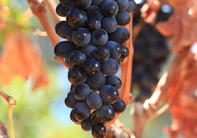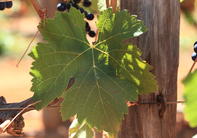Description
Shiraz is a red wine cultivar with distinct smoky flavour. It developed out of a crossing between the near extinct varieties, Dureza and Mondeuse blanche.
Origins
It was previously thought hat Shiraz originated in the old Persian town of Shiraz in present-day Iran. DNA testing in the late-1990s however confirmed France to be the true country of origin, since both parent varieties from which Shiraz developed, have their origins in the south east of France. The variety has been grown in the Rhone valley for the past few hundreds of years. Its popularity there grew since the end of the 1960s, as a blend with Grenache noir and Carignan.Other Names
In most of the rest of the world, the variety is referred to as Syrah. New World producers, such as South Africa and Australia, have recently started using these terms to indicate a style of wine. Syrah is reserved for more traditional Rhone Style wines with restrained fruit flavours, while Shiraz is used for more modern wines of which the berries are picked at a riper stage and that have higher alcohol levels and more upfront fruit flavours.Production in South Africa
It is uncertain when Shiraz arrived in South Africa. According to one theory, Governor Simon van der Stel brought it to South Africa at the end of the 1600s. Another holds that James Busby, the Scotch viticulturist who started Shiraz production in Australia, left cuttings in Cape Town on his way from Europe in the 1840s.
The first vineyards were planted in Groot Constantia towards the end of the 1890s, but the variety’s popularity was limited because of low production and producers not being rewarded for the quality. A lot of the plant material was also infected with virus back then.
Bernard Podlashuk, referred to as the “Father of Shiraz in South Africa”, was the first to bottle Shiraz as a single varietal wine in 1957. Between 1992 and 2016, the area under production increased from roughly 900 ha to nearly 10 000 ha, resulting in Shiraz becoming the second biggest planted red variety in the country.
The variety performs well on medium and light soils, and is adaptable to various climatic conditions. Vineyards are found in all the production regions of South Africa, with Paarl having the biggest area under production, closely followed by Stellenbosch and the Swartland. It makes out a large percentage of the varieties produced in the Cape South Coast.
Growth and Ripening
Vines have a limp, creeping growth habit with good vigour. Production is moderate to high, averaging around 10 t/ha and 15 t/ha. Grapes ripen late mid-season, from the end of February to the first half of March.
Berries and Leaves
The berries are medium small, oval and blue black in colour. The skin is thin but tough and the flesh is very juicy. The berries take on a shrivelled appearance when left on the vines for extended periods. Leaves are dull green, relatively large, longitudinal and five lobed.
Pests and Diseases
The variety is fairly resistant to diseases, but Shiraz disease and Shiraz decline may be a problem with certain clones. The variety is sensitive to wind damage.Use
It is used for the production of single varietal wines and a vast number of blends, such as the Cape blend, which has to contain at least 30% and no more than 70% Pinotage, or classical Rhone blends. It is even used to make sparking red wine.Taste
The flavour profile of Shiraz depends on various factors, including climatic conditions, the area of production, the way the vineyards were managed as well as the way the wine is matured. The wines generally have smoky, peppery, spicy and fruity flavours, with warmer inland areas producing more distinct fruity flavours.
Vineyards with an open canopy, medium yield and grapes that have been left to fully mature are associated with ripe plum and berry flavours, while those obtained from vineyards with fairly low yields produce more spicy aromas. The use of oak also has a distinct impact on the outcome of the wine, depending on the way and the type of oak used.
By Glenneis Kriel

 Initially many of our South Africa Shiraz wines were made in this bolder fuller-bodied idiom, but the mid to late 2000s saw the start of the...
Initially many of our South Africa Shiraz wines were made in this bolder fuller-bodied idiom, but the mid to late 2000s saw the start of the...